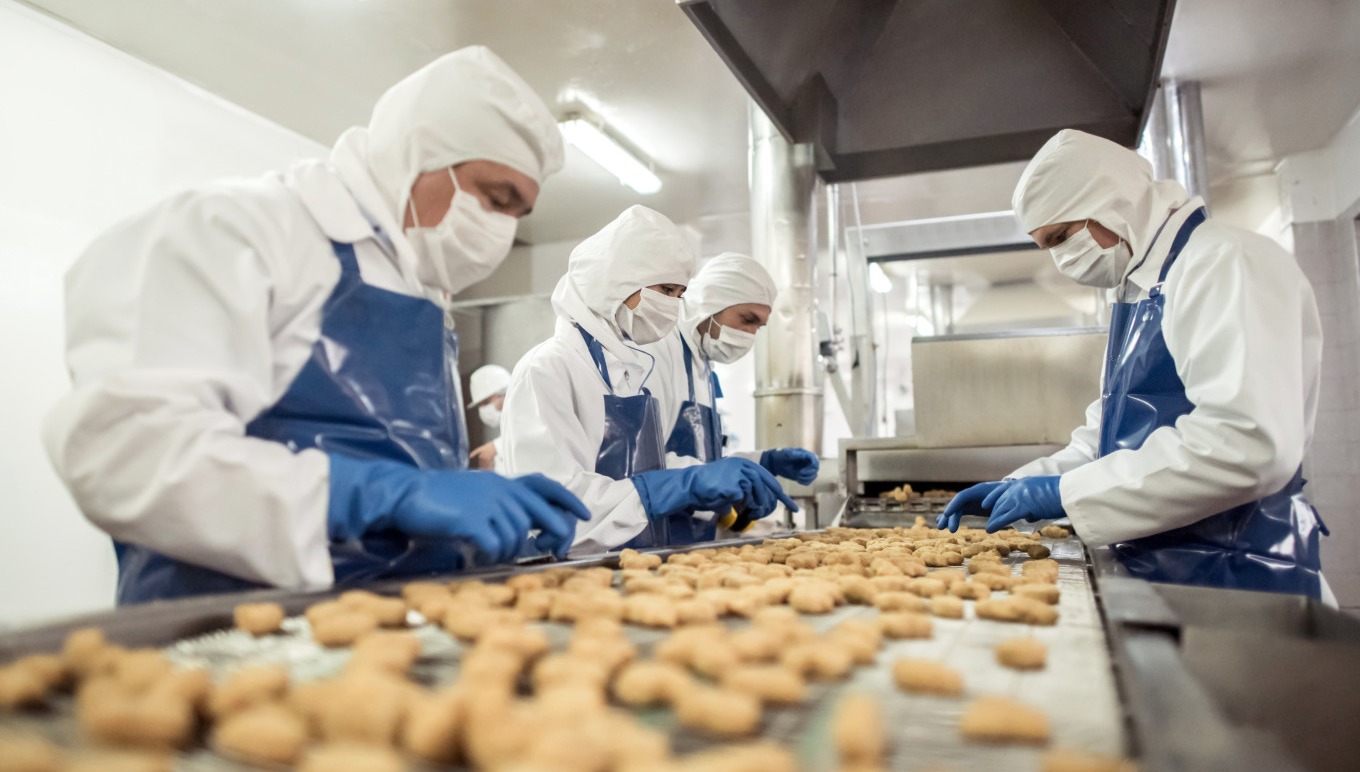Lean Production Is the Key Ingredient for Scaling Your Food & Beverage Company. How Can You Achieve It?
Lean Production Is the Key Ingredient for Scaling Your Food & Beverage Company. How Can You Achieve It?
Lean Production Is the Key Ingredient for Scaling Your Food & Beverage Company. How Can You Achieve It?
Nov 10, 2023
 Aptean Staff Writer
Aptean Staff Writer 
It's not easy gaining a foothold in the food and beverage industry. 75% of consumer packaged goods (CPG) brands earn less than $7.5 million during their first year, and only 3% exceed first-year sales of $50 million.
Even companies that launch successfully can struggle to grow longer-term; and products aren’t always the challenge. For many processors, manufacturers and distributors, scaling operations to meet rising demand becomes a major obstacle.
Most food and beverage companies start out with a lean production model, but how do you maintain this lean set-up as you grow—without compromising output? Let’s take a deeper dive.
Automation Is a Key Component To Being Growth-Ready
Gearing up for growth is challenging for any company, but rapidly changing trends place even greater pressure on food and beverage brands. Sudden surges in sales, like those triggered by products going viral on social media, can leave your company scrambling to fulfill demand and outstrip production capabilities.
In an exclusive Aptean survey, 74% of North American food processors, manufacturers and distributors said they find adapting to constantly evolving consumer preferences a significant challenge.
Recently, Aptean released an ebook for fast-growing brands, looking at the key ingredients your company needs to capitalize on sales opportunities and scale operations.
While every ingredient plays a role in the end product, automation is the key component to being growth-ready. The less your brand relies on manual processes, the quicker you can scale production without compromising on quality.
Why is it so important? Capacity is one factor. With automated operations, you’re not held back by the size or limits of your workforce. When you’re in a period of rapid growth it’s easy to end up “chasing your tail” because you can’t find and hire people with the right skills fast enough to keep up with demand.
By digitizing production, you’re less reliant on human input—and digital processes are better designed to scale with your business. Technology can also help you manage critical processes that influence your speed to market. For example, automatically reordering ingredients when levels reach a certain threshold, or monitoring equipment performance with a preventative maintenance plan to help ensure production isn’t interrupted by asset failures.
Get your software choices right and you’ll have complete visibility over end-to-end production; meaning you can swiftly identify and eliminate any bottlenecks. Your entire infrastructure can run much more efficiently, enabling your business to maintain a lean operation as you scale.
of North American food processors, manufacturers and distributors said they find adapting to constantly evolving consumer preferences a significant challenge.
Which Technologies Are Critical To Lean Production?
Many fast-growing food and beverage brands understand the value of digital transformation, but are blinded by choice. If you only have the budget to invest in one, two or three systems, which ones should you prioritize?
Based on our decades of experience supporting companies in the food and beverage industry, we’ve found three technologies are critical for lean production:
1. Enterprise Resource Planning (ERP) Software
If you can only invest in a single tool, ERP software can be a game-changer. It’s a comprehensive solution for optimizing everything from inventory management to order processing, to help ensure your products are manufactured and quality controlled in the most efficient manner.
Because ERP software is multi-functional, it replaces the need to invest in (and integrate) several niche solutions. Even better, dedicated food ERP systems will give you additional industry-specific features. For example:
Automatic bill of material (BOM) calculations that link with product labelling to ensure you’re including the correct values and allergen information, reducing mistakes and product recalls.
Full forward and backward lot traceability to identify raw materials used in end-products during quality control processes, and minimize the impact of product recalls.
Key performance indicators (KPI) tracking using terminology and measurements specific to the food and beverage industry to identify areas for improvement and cost reduction.
2. Overall Equipment Effectiveness (OEE) Software
OEE helps food and beverage companies monitor and maximize the productivity of their operational equipment, highlighting how well it’s performing and identifying areas of inefficiency.
Asset management is often a profit drain in food and beverage production, with downtime costing companies up to $260,000 per hour.
Food OEE software tackles this issue by:
Connecting your equipment to measure availability, performance and quality, so you can make strategic asset management decisions.
Analyzing root causes of downtime and disturbances to drive continuous improvement.
Automating alerts, production status updates and reports to streamline internal resources and reduce their associated costs.
The aforementioned Aptean research has found that 41% of food companies digitally transforming their maintenance operation are already experiencing KPI improvements.
3. Enterprise Asset Management (EAM) Software
EAM works hand-in-hand with OEE, helping companies to optimize asset management and maintenance.
It’s particularly effective if you’re moving from reactive to preventative maintenance programs, as it can help to reduce unplanned downtime and intelligently schedule planned preventative maintenance work. For example, food and beverage EAM software allows your organization to:
Submit, manage and update work requests through a single platform that your whole maintenance team can access.
Integrate planned and emergency maintenance work, prioritizing jobs that have the greatest impact on production capabilities.
Gain visibility into maintenance history, breakdown causes and other data to support critical decisions—for example, when to repair versus when to replace machinery.
A well-oiled maintenance program will improve the productivity of your assets while lowering costs to maintain them.
of food companies digitally transforming their maintenance operation are already experiencing KPI improvements.
Choose Cloud-Based Software for a Scalable Technology Stack
While ERP, OEE and EAM systems can help you achieve rapid growth while still running lean, that’s not the end of the story. We’ve already mentioned the benefits of choosing food-specific software, and there are other factors that influence how your technology stack supports business scalability.
For example, cloud-enabled software can play a pivotal role in brand expansion. With cloud-based ERP, OEE and EAM systems, your company can easily add new digital capabilities in line with production needs, deploying features remotely without technical complexity.
Our Food and Beverage 2024 Trends and Outlook for North America Report found 60% of processors, manufacturers and distributors are exploring or investigating a move to the cloud, and those already using cloud-based technologies predict higher revenue in 2023 than those using on-premises software.
Cloud-based software is site agnostic too, which gives you the option to add new users and facilities as your business grows. On-premises technology requires servers at every site or connections to external data centers. It’s quicker and cheaper to roll out software via the cloud and connect with other platforms via application programming interface (APIs).
Read more on this topic with our blog, Why Move Your Food and Beverage ERP to the Cloud? and our also our ultimate guide to cloud ERP vs on-premises deployments.
Capitalizing on Opportunities To Drive Brand Growth
Production efficiency isn't just about fulfilling demand; it's about capitalizing on opportunities and driving brand growth. In an industry where trends can change overnight, agility is invaluable. Automating core processes will enable your company to keep up with consumers' demands while maintaining a lean operation.
While any new technology is a significant investment, being tactical about the tools you deploy will maximize the benefits of automation without draining your budget—particularly if you choose a cloud-based, industry-specific solution.
What are the other ingredients for rapid brand growth? Download Aptean’s Challenger Brand Recipe Book to find out.
Start Transforming Your Food and Beverage Business
If you're ready to move your business to the next level, we'd love to help.



